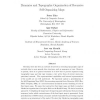Free Online Productivity Tools
i2Speak
i2Symbol
i2OCR
iTex2Img
iWeb2Print
iWeb2Shot
i2Type
iPdf2Split
iPdf2Merge
i2Bopomofo
i2Arabic
i2Style
i2Image
i2PDF
iLatex2Rtf
Sci2ools
NECO
2006
2006
Dynamics and Topographic Organization of Recursive Self-Organizing Maps
Recently, there has been an outburst of interest in extending topographic maps of vectorial data to more general data structures, such as sequences or trees. However, at present, there is no general consensus as to how best to process sequences using topographic maps and this topic remains a very active focus of current neurocomputational research. The representational capabilities and internal representations of the models are not well understood. We rigorously analyze a generalization of the Self-Organizing Map (SOM) for processing sequential data, Recursive SOM (RecSOM) (Voegtlin, 2002), as a non-autonomous dynamical system consisting of a set of fixed input maps. We argue that contractive fixed input maps are likely to produce Markovian organizations of receptive fields on the RecSOM map. We derive bounds on parameter (weighting the importance of importing past information when processing sequences) under which contractiveness of the fixed input maps is guaranteed. Some generaliz...
| Added | 14 Dec 2010 |
| Updated | 14 Dec 2010 |
| Type | Journal |
| Year | 2006 |
| Where | NECO |
| Authors | Peter Tiño, Igor Farkas, Jort van Mourik |
Comments (0)

